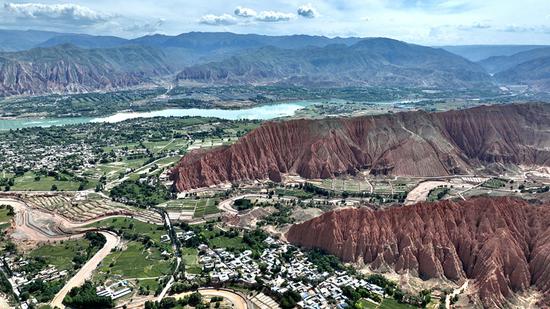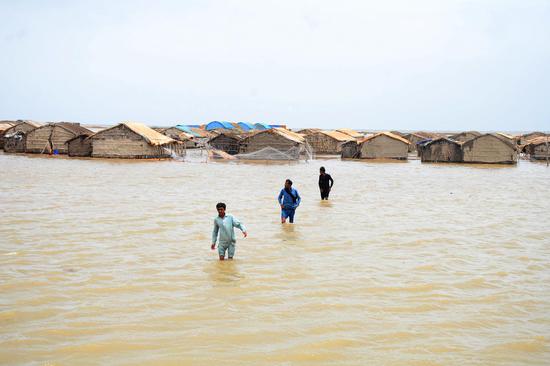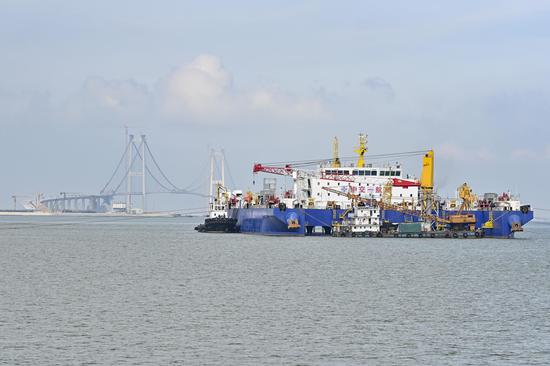The latest scorching heat wave has been burning the northern part of China over the past week with high temperatures in multiple places surpassing 40 C, and meteorologists predict this year could be the hottest or second-hottest on record, partly due to the El Nino phenomenon.
Since June 13, high temperatures above 35 C have been hitting multiple areas across China including the central and western parts of North China's Inner Mongolia Autonomous Region, the Beijing-Tianjin-Hebei region, the central and northern parts of Central China's Henan Province, the central and western parts of Shandong Province, and the northern parts of Jiangsu and Anhui provinces, with the temperature in some areas exceeding 37 C, according to a report from China News Service.
The high temperatures peaked on Thursday in the northern parts of the country, with the top 10 high readings appearing in cities in North China's Hebei Province. Shijiazhuang in Hebei became the first provincial capital city to exceed 40 C this year, and places such as Chicheng county in Zhangjiakou city and Fengning in Chengde all set new records for the highest temperature in June.
The National Meteorological Center (NMC) said that this heat wave so far has the widest range and strongest intensity this year, covering North China and regions along the Yellow River and Huaihe River. The temperatures in some places have set new records.
Southern parts of China also experienced a round of extremely hot days as early as May. Particularly on May 31, the temperature in Qiaojia county in Southwest China's Yunnan Province surpassed 44 C.
The latest round of heat wave in the northern parts of China is mainly due to the gradual development and strengthening of a high-pressure warm ridge located in the Northwest China's Xinjiang Uygur Autonomous Region, which has been moving eastward and affecting areas including North China and the regions along the Yellow River and Huaihe River.
In the context of global warming, extreme high-temperature weather has become increasingly frequent in recent years. According to the World Meteorological Organization (WMO), temperatures in Asia have been rising year by year, with a more significant increase observed after 2010.
The entire world has been experiencing extreme temperatures. Researchers have indicated that with rising ocean temperatures worldwide and the onset of El Niño in the Pacific, 2023 could potentially become the hottest year on record, according to a report from China Science Daily.
The previous hottest year on record happened in 2016, but recent temperature records suggest that temperatures recorded in 2023 may be approaching those in 2016.
El Niño was formed and is expected to further contribute to the global warming process and bring about new peaks in global warming. The WMO released a report on May 17 stating that due to the accumulation of greenhouse gases and the influence of natural El Niño events, global temperatures may reach record levels in the next five years, according to China News Service.
There is a potential swift switch this year from the La Niña period, which lasted three years, toward the El Niño phenomenon, which has a warming effect on global temperatures and constitutes further temperature rises, Ma Jun, director of the Beijing-based Institute of Public and Environmental Affairs, told the Global Times on Monday.
According to Ma, whether this year will become the hottest year in history will depend on factors such as the intensity of the El Niño event and the timing of its occurrence, and these factors will need to be closely monitored and studied to assess the potential impact on global temperatures.
More meteorologists think that if a strong El Niño phenomenon occurs at the end of this year, then next year will possibly be hotter, Ma said.
In terms of the impact of El Niño on China, analysis of historical data by the National Climate Center has shown that during El Niño years, the regions that include the southern part of North China, the northern part of Central China, the central part of East China, and the eastern part of Northwest China can experience higher temperatures in summer. Some areas may experience more than 30 days of high temperatures, according to China News Service.
According to Ma, the El Niño phenomenon typically brings about a higher likelihood of flooding in the southern part of China and drought in the northern part. This year, it is important to pay attention to potential flooding issues in the Yangtze River basin, as well as the possibility of drought in the northern regions, due to reduced rainfall and extreme high temperatures, which should be taken into consideration when assessing the potential impacts of El Niño on China.
Besides, the early arrival of high-temperature days was also reflected from the early release time of the high temperature heat stroke weather forecast this year. The Public Meteorological Service Centre of the China Meteorological Administration (CMA) issued the first forecast for high temperatures and heat stroke for this year on June 15, 13 days earlier than the average release date of most years.


















































 京公网安备 11010202009201号
京公网安备 11010202009201号